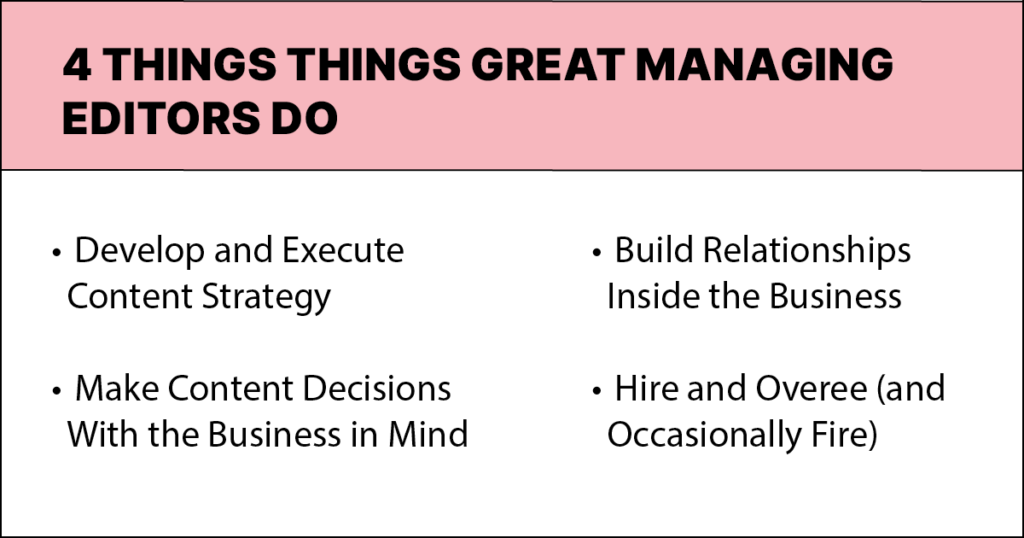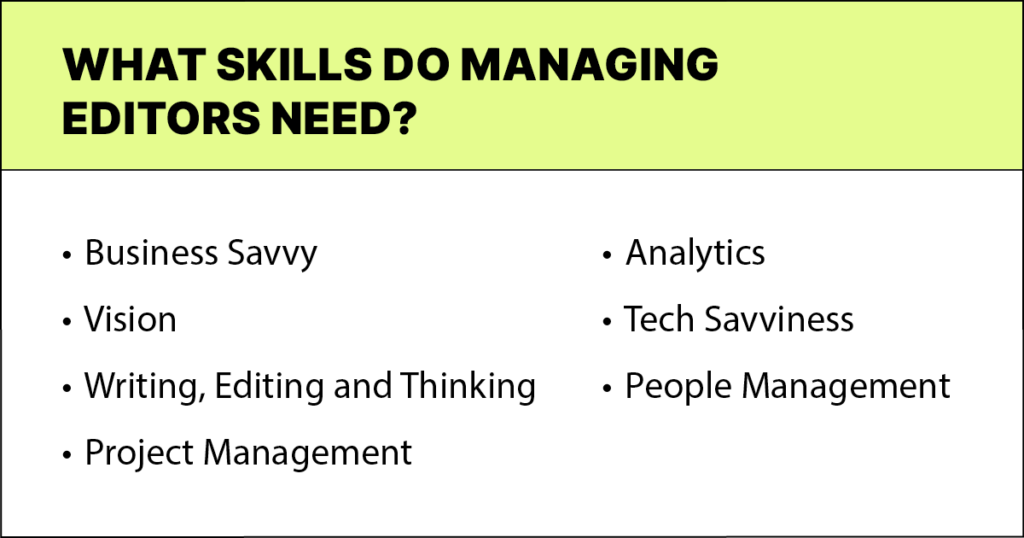Every publication needs someone who oversees the content calendar and makes sure content is vetted, edited and published. You might call this person a managing editor. But as content production becomes increasingly streamlined and automated, traditional content roles are changing. What is a managing editor in the age of AI and content marketing?
In one sense, the role hasn’t changed. Managing editors still own content at their organizations. They hire and oversee staff. They organize the work and connect it to the overall business goals and strategy. They do all of this while working with and across teams to get things done.
If your brand relies on regular content production as part of its marketing or communications, you have a managing editor — no matter what title they go by.
Learn more about this vital and unheralded role and how it fits into your brand publication or content marketing team. We’ll explore what managing editors do and the skills and resources they need to succeed.
What Is the Role of a Managing Editor?
A managing editor is responsible for the day-to-day operations of a publication, which includes overseeing writers, editors and other production personnel. Managing editors often report to the editor in chief or an equivalent title.
I’ve been a managing editor. I managed a workplace leadership blog and newsletter for 10 years, but if all I had done was oversee the content production process, I wouldn’t have been a managing editor. Yes, I combed through submissions, coordinated with co-workers and contributors, and edited and uploaded blog posts into our content management system. I picked stock art and made sure we had the right tags and SEO elements before publishing.
All this work was important, but most of that was editing and administration. Editing is vital work, but it’s not always managing.
So what does a managing editor do, by my definition? I took full responsibility for what was published and when — and what we didn’t publish. I was the brand protector. Anything put out under that brand had to represent our mission and values as well as our style guide and editorial best practices (and represent the authors accurately and fully, too).
Here are a few more things managing editors do.
Develop and Execute Content Strategy
A good content strategy is short and simple but capable of flexibility and growth. The managing editor identifies the audience, the big ideas, the distribution strategy and the audience’s intended reaction.
With that comes approving the editorial calendar, handing out assignments, writing and editing as needed, and ensuring everything stays on track throughout — and repeating the cycle.
Content marketing is so much more than producing glorified ads — it’s about communicating big ideas. So don’t skimp on planning that calendar or how to communicate those ideas. A managing editor creates a content calendar that fits the brand’s needs without sacrificing personality or the chance to say something new.
Executing your content strategy also requires paying attention to performance. You need to know what metrics to track, what signals success, and how to use that data to modify and evolve the content strategy. All of this supports the business strategy. Speaking of …
Make Content Decisions With the Business in Mind
Managing editors also make complex business decisions and should ensure all content initiatives tie directly to business goals.
That doesn’t mean you can’t create inspiring, daring, even controversial content. It just has to make sense for the brand — especially when you’re part of a content marketing team.
Go back to my leadership blog for a moment. Its business purpose was to attract great thought leadership, burnish the brand’s reputation and provide top-notch content for the flagship product (a highly profitable email newsletter). The email subject line often reflected the latest blog post — a powerful synergy that drove high engagement with the content (and the advertisements within).
Managing a publication doesn’t mean you have carte blanche. If a piece of content wasn’t related to workplace leadership, with practical advice and by somebody with some level of expertise or perspective, I wouldn’t publish it. That was what my audience wanted and expected — and needed.
Saying “no” or “What if we did this instead?” isn’t always easy. But that discipline made it one of the company’s top revenue vehicles and biggest subscriber bases — with higher-than-average reader engagement to boot.
At your publication, ask yourself, “What are the big ideas that align with the organization’s goals?” Thought leadership is a critical component of content strategy, and you’re the organization’s gatekeeper. You need to collect, pitch and curate the big ideas to propel the business. The company relies on those well-communicated ideas to attract followers (and customers) through compelling content leadership.
Build Relationships Inside the Business
Managing editors should work closely with sales and marketing teams — and everyone else in the organization. This is important whether you’re part of a brand, agency or pure editorial publication.
Great managing editors connect individuals across their organization to build a cohesive brand. They rely on expert advice from each facet of the organization because every role is important, and each player deserves to have their voice heard. The managing editor has the privilege of pulling these voices together to create engaging, unique content.
The handful of sales trips I took were some of the most enriching and informative experiences of my editing career. I got to see my smart and thoughtful colleagues in action, learning about not only sales but also how they leveraged our editorial expertise to interest advertisers. We had a great audience, and we created great content — of course they’d want their premium brand next to it.
In turn, when my sales colleagues sold sponsored content, I was in a better position to suggest content ideas that met the advertisers’ goals while also being acceptable to our discerning audience.
Hire and Oversee (and Occasionally Fire)
Managing editors typically oversee staff, often directly, although larger content teams will have layers of management. You’re responsible for hiring and overseeing a variety of content roles, including freelancers and part-timers.
Managing editors have to oversee the content creation process, which may vary depending on your team’s size and the scope of your work. At a bigger organization, you might have a full content team of writers, editors, designers and marketers. At a small company, you might create a lot of content yourself.
No matter the size of your team, you likely will have in-house staff, outsourced freelancers or agencies, or some combination of those. Your job is to ensure all those roles stay filled and that everyone works together seamlessly.
These duties and responsibilities include supervising writers and editors, too. You’re part-coach, part-taskmaster, and fully accountable for hitting deadlines and goals. You need to track performance, coach people and make hard staffing decisions when the situation warrants it.

What Skills Do You Need as a Managing Editor?
Being a managing editor isn’t easy, and the job can seem never-ending. You make critical business decisions nearly every day, and you must flow among people management, brainstorming, editing and navigating the latest algorithm changes, just to name a few tasks.
While there’s no one definitive managing editor job description, you might think of the role as being a mix of hard and soft skills.
Hard skills are the specific, technical skills required to do the job. For managing editors, these might include copy editing, fact-checking and project management. Soft skills are interpersonal skills that help you succeed in any job — such as communication, problem-solving, team-building and conflict resolution.
(One skill you don’t necessarily need? A degree in journalism.)
Learn more about some of the skills you need in this job.
Business Savvy
You need to speak the language of the C-suite. Do you understand the business goals? Do you see how content supports customer acquisition? Most importantly, can I translate that information to other employees and the organization’s external audience? Good managing editors interpret all of this data and more to demonstrate just how powerful content can be.
If your organization is branching out into multilingual content marketing, for example, that probably means you’re spending more time and money on content — and in a language your executive team might not speak, much less be comfortable with. If you can’t make the business case, your bid for content across languages will come off as a lark rather than a way to build a deeper kind of trust with your audience.
Vision
Can you connect the brand’s vision to the content? Can you connect the content to your staff and your intended audience? As a managing editor, you don’t need to give fiery speeches, but you do need to help others see your vision — and their role in achieving it.
Visionary managing editors inspire their teams to create and execute ideas, both on their own and collaboratively. You need to envision potential risks and obstacles, and you also need peripheral vision — seeing what the competition is up to. Throughout, you must dream big but act wisely based on the data and resources you have.
Writing, Editing and Big-Picture Thinking
This feels obvious, but it’s not simply being good at wrangling content yourself. Yes, being a good writer and editor is important, but can you impart the “why?” of your editing philosophy? Why do you make certain word choices and style decisions? Why is it important to approach your audience in X way?
And because content marketing (and journalism!) needs to keep the audience in mind, your big-picture thinking is as important as your ability to proofread. Your writing and editing skills can make all the difference between a blatant sales pitch and a thoughtful, provocative piece of content.
Project Management
Project management is one of the biggest differentiators between editors and managing editors. Do you know how to juggle an array of assignments and tasks as well as other people’s schedules? Do you understand how people work best?
When you understand the unique talents and thinking preferences of each of your team members, you foster a better culture and are better prepared to deliver effective project management.
Analytics
As the managing editor, you not only oversee content creation but also track and analyze how it performed. This includes performing content audits on existing pieces and revamping older ones to match your audiences’ needs. Data provides a map, and reading the numbers tells a managing editor which direction to take.
Tech Savviness
Even if you work at a print publication, your day-to-day life is full of technology: content management systems, communication tools, apps and logins, not to mention the technology you have to navigate for analytical purposes.
You need judgment and prudence as a managing editor. Not every tech platform is right for every team, and you might need tech that can scale with your growth or changing needs. The decisions you make when adopting technology can affect your success for years to come.
In my time as a managing editor, I’ve seen both sides. I’ve worked with incredible homegrown technology that enabled best-in-class content production. I’ve also seen otherwise good tech deployed badly — and the years of missed opportunities that followed.
People Management
Management skills are part of every job, but they’re easy to overlook. You might think, “I’ll set the schedule, tell talented people what to do, and that’s it.” And that can work — for a time. But eventually you need to learn how to coach people to do the work.
Your management skills make the difference between people struggling and finding their potential. Not everyone works out, but if you find yourself continually frustrated with your team’s poor output, take a look in the mirror. What do you do well? What do you do badly? What are you failing to do or address about yourself?

What Resources Do You Need as a Managing Editor?
Every successful managing editor needs three types of resources: people, time and technology. Here’s a quick look at each of those areas.
The Right People
A managing editor needs to have a team of talented writers, editors and other production personnel who can handle the content creation process.
When you put together a great team, you have a collaborative support staff that understands your vision and wants to help you execute it. They understand the business goals and how content serves them. They can think independently but also ask for help from their teammates and manager. They feel safe giving feedback to help the managing editor make the right decisions and to suggest adjustments as conditions change.
Having the right people on your side also includes leadership. Without the management team’s buy-in, content won’t be considered strategically important (or get the budget it deserves). You might still succeed, but you may face longer odds.
Time for Content Strategy
Managing editors need time to regularly review and adjust their strategy, as this job isn’t about just heads-down execution.
Think about it: A good blog post about a subject you’re familiar with can still take time to get right. Strategy is less straightforward and has big consequences. As a managing editor, you must identify the audience and its needs, determine the ideal content formats, and figure out when and where everything will be published. Crafting the content strategy requires research, analysis and planning. Furthermore, you must revisit this strategy as your business evolves or conditions change.
The extra effort you put forth at the beginning pays off exponentially in better crafted, more thoughtful content.
The Right Technology
A managing editor needs access to technology that makes it easier to identify trends and measure success. This might include software that helps with project management or how you organize shared files.
Look at the technology your organization already uses. Does your content team take advantage of the licenses available? Are there integrations between your content management system and other systems, like Google Analytics, customer relationship management systems or social publishing platforms?
Speaking of social, do you know where your traffic comes from and where your content performs best? You need the right analytical tools (and training) so you can accurately track what works and what doesn’t.
Does Your Brand Need a Managing Editor?
Managing editors go by many names. But if your brand publication struggles to put out content regularly, isn’t cohesive and consistent in tone, or lacks direction, you probably don’t have anyone who feels empowered to lead your content team.
Serving as a brand’s managing editor isn’t easy. That’s why we created Managing Editor magazine — to give people what they need to succeed in the role. Next time someone asks, “What is a managing editor?” you know where to send them.






